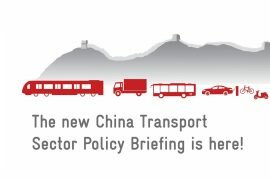China Transport Sector Policy Briefing – October 2018
 The October edition of our China Transport Sector Policy Briefing is here! The Sustainable Mobility Team at GIZ in China provides you with a monthly summary of new important policies in China’s transport sector.
The October edition of our China Transport Sector Policy Briefing is here! The Sustainable Mobility Team at GIZ in China provides you with a monthly summary of new important policies in China’s transport sector.
Please click here to download: China Transport Sector Policy Briefing October 2018
In October, the Three-Year Plan on the Restructuring of the Transport Sector has set its focus on the shift from road to rail and waterway, while provincial and municipal policies targeted the promotion of new energy industries and new energy vehicles (NEVs). Safety has received prioritization in Beijing with a series of regulations for light electric vehicles.
Restructuring of the transport sector, new energy and NEV promotion at provincial and municipal level, light electric vehicle regulations in Beijing
This month another major plan for the transport sector has been released by the State Council. The Three-Year Plan on the Restructuring of the Transport Sector focuses on the shift from road to rail and waterway. By 2020, key ports, both coastal and inland, shall be covered with a distribution railway network. Furthermore, by 2020, over half of new and updated vehicles in urban areas, shall be new energy vehicles or clean energy vehicles, with a target of 80% in key areas.
The State Council handed this task over to the following ministries: Ministry of Commerce (MOFCOM), Ministry of Industry and Information Technology (MIIT), National Development and Reform Commission (NDRC), Ministry of Transport (MOT), Ministry of Finance (MOF), State Administration of Taxation (SAT), Ministry of Natural Resources (MNR), Ministry of Housing and Urban and Rural Development (MOHURD), Ministry of Ecology and Environment (MEE) and General Administration of Customs (GACC). The State Council officially asked them to come up with policies and administrative measures to promote NEVs, Intelligent Vehicles, the import of foreign cars, the trade of second-hand cars as well as the recycling of cars.
At provincial level, we already see many moves to further promote NEVs through long-term actions. Shandong Province has just released its Ten-Year Plan for the Development of New Energy Industries in Shandong Province (2018-2028): Electric vehicles, plug-in hybrids and hydrogen fuel cell vehicles are expected to be the most important pillars of this development. At the same time, The Yunnan Provincial Government announced its Working Plan for Accelerating the Promotion and application of NEVs in Yunnan.
The city of Tianjin with its population of more than 12 million people sets another example with its Three Year Action Plan for the Development of New Energy Industries in Tianjin (2018-2020), which promotes hydrogen energy and fuel cells, NEVs as well as the development of lithium-ion batteries.
Beijing’s government has been very active again this month: It issued a Beijing White Paper on Intelligent and Connected Vehicles (ICVs) that forecasts that the ICV industry will be worth 13 billion EUR by 2022. In the long-term, the White Paper envisions Beijing to be home to a top of the world cluster of ICV industries, with a vibrant and innovative ecosystem for automated driving complemented by a “secure, efficient, green and civilized ICV society”. In the near future, we may see Beijing establish a world-class system of ICV technologies which can satisfy the requirements of Level 4 automation, an efficient and secure demonstration zone of new intelligent mobility of more than 500 square kilometers, and an ICV manufacturing and user service system.
And it seems Beijing prepares itself for reducing complexity and vulnerability of the transport environment. One major source of accidents in the city is its electric scooters and three-wheelers. Therefore, The Standing Committee of the Beijing Municipal People’s Congress released the new Regulations on the Administration of Light Electric Vehicles, valid from 1 November 2018. This affects all non-commercial electric bikes, electric scooters, electric hoverboards as well as electric three-wheelers and light electric four-wheelers.
All light electric vehicles in Beijing need to be registered with the Beijing Traffic Management Bureau before 30 April 2019, but only electric bicycles with a maximum speed of less than 20km/h, a maximum weight of less than 40kg may receive permanent license plates which allow for unrestricted access to Beijing’s roads. All others may access Beijing’s roads for a three-year interim period with a temporary license plate but will not be allowed on public streets after that. All electric self-balanced scooters and hoverboards will strictly be prohibited on public streets from 1 November 2018 onwards. Any violation will be fined, vehicles or license plates may be confiscated by the police.
We hope you enjoy reading this month’s policy briefing. Any feedback or suggestions are welcome.
Sandra Retzer & the GIZ in China Sustainable Mobility Team






Comments are closed.